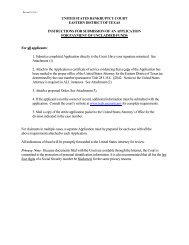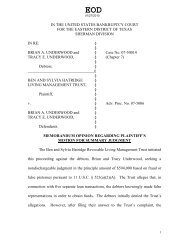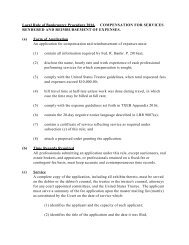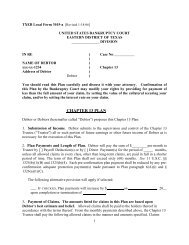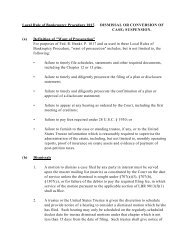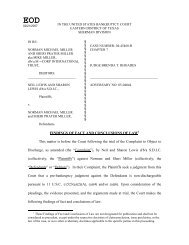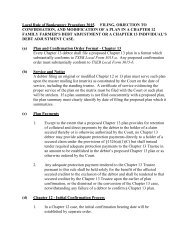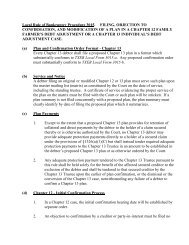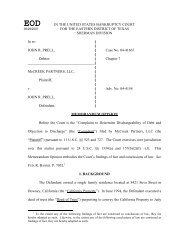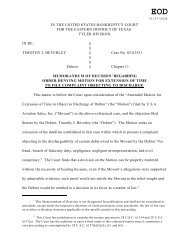JOSEPH MANCUSO, § Case N - Eastern District of Texas
JOSEPH MANCUSO, § Case N - Eastern District of Texas
JOSEPH MANCUSO, § Case N - Eastern District of Texas
You also want an ePaper? Increase the reach of your titles
YUMPU automatically turns print PDFs into web optimized ePapers that Google loves.
IN THE UNITED STATES BANKRUPTCY COURTFOR THE EASTERN DISTRICT OF TEXASSHERMAN DIVISIONIN RE: §§<strong>JOSEPH</strong> <strong>MANCUSO</strong>, § <strong>Case</strong> No. 04-41757§ (Chapter 7)Debtor. §____________________________________§KENNETH P. SILVERMAN, ESQ., as §Trustee for the Estate <strong>of</strong> CHIEF §EXECUTIVE OFFICERS CLUB, INC., a §Chapter 7 Debtor in the Southern <strong>District</strong> §<strong>of</strong> New York, §§Plaintiff, §§v. § Adv. No. 05-4017§<strong>JOSEPH</strong> R. <strong>MANCUSO</strong>, §§Defendant. §FINDINGS OF FACT AND CONCLUSIONS OF LAWThe Plaintiff, Kenneth P. Silverman, Esq., initiated this action by filing aComplaint against the Defendant, Joseph R. Mancuso, on January 28, 2005. In theComplaint, the Plaintiff objects to the Defendant’s discharge pursuant to 11 U.S.C.§727(a)(3), (a)(4)(A), (a)(5), (a)(6)(C) and (a)(7). The Court held a trial on theComplaint on January 17, 2006, and, at the conclusion <strong>of</strong> the trial, set the matter for alater ruling. Pursuant to Rule 52 <strong>of</strong> the Federal Rules <strong>of</strong> Civil Procedure, as adopted andapplied to this adversary proceeding by Rule 7052 <strong>of</strong> the Federal Rules <strong>of</strong> BankruptcyProcedure, the Court enters the following findings <strong>of</strong> fact and conclusions <strong>of</strong> law:A. Findings <strong>of</strong> FactPrior to trial, the parties entered into a Joint Pre-Trial Order in which they
stipulated to numerous facts. Based on these stipulations and the evidence presented attrial, the Court makes the following findings <strong>of</strong> fact:1. The Defendant Founds the Original CEO Club1. The Defendant holds an electrical engineering degree from WorcesterPolytechnic Institute and a master’s degree in business administration from the HarvardBusiness School. The Defendant is credited as the author <strong>of</strong> more than 20 booksregarding business and management matters.2. The Defendant founded the Chief Executive Officers Club, Inc. (the“Original CEO Club”) more than 25 years ago. The concept grew in popularity over theyears, and numerous local chapters formed as separate corporations in the United Statesand China, among other places (collectively, the “CEO Club Chapters”). Members paydues and pay to attend programs sponsored by the Original CEO Club or the CEO ClubChapters. Based on oral agreements between the Defendant, as the chief executive<strong>of</strong>ficer <strong>of</strong> the Original CEO Club, and principals <strong>of</strong> certain CEO Club Chapters, thosechapters shared their income with the Original CEO Club.3. The Defendant founded the Original CEO Club as a nonpr<strong>of</strong>it corporation.From 1988 until 2001, he operated the Original CEO Club out <strong>of</strong> his home at 180 VarickStreet in New York, New York. For many years, the Defendant’s wife, Karla, was hisbusiness partner.4. The Defendant had signatory authority on bank accounts belonging to theOriginal CEO Club and many <strong>of</strong> the CEO Club Chapters. His practice was toperiodically sign hundreds <strong>of</strong> checks on each <strong>of</strong> the accounts and to leave the blankchecks with the principals <strong>of</strong> the chapters. Additionally, at least 25 people had authorityFINDINGS OF FACT AND CONCLUSIONS OF LAW – Page 2
to sign checks and other documents for the Defendant.5. The Defendant and his landlord, 180 Varick Street Corporation, engagedin a long legal fight regarding the lease <strong>of</strong> the premises at 180 Varick Street. TheDefendant was a guarantor on the lease, not a tenant. One <strong>of</strong> the Defendant’s non-pr<strong>of</strong>itcorporations was the tenant on the lease.6. The Defendant ultimately lost the legal battle with 180 Varick StreetCorporation. A judgment was entered in favor <strong>of</strong> the landlord and against the tenant aswell as the Defendant, personally, as a guarantor <strong>of</strong> the lease.7. The Defendant moved to 457 Washington Street in New York City in2001. According to the Defendant, his wife subsequently moved to 47 West Street, #5C,in New York City. The Defendant conducted his business out <strong>of</strong> both addresses.8. In a deliberate effort to thwart the landlord’s ability to collect thejudgment against him, personally, the Defendant arranged his finances to make hisincome difficult to trace. He reported taxable income <strong>of</strong> $12,000 or less for 2001, 2002and 2003. He received these funds from family members, who, in turn, received thefunds from either the Original CEO Club or a CEO Club Chapter.9. The Defendant, as the chief executive <strong>of</strong>ficer <strong>of</strong> the Original CEO Club,entered into oral agreements with various CEO Club Chapters for the payment <strong>of</strong> hisbusiness and personal expenses. These CEO Club Chapters regularly paid theDefendant’s expenses at his request. However, it is not clear from the record when theseagreements were formed, and the Defendant could not recall which CEO Club Chaptershad entered into oral agreements to pay his expenses.10. The Defendant made his requests for payment either over the telephone orFINDINGS OF FACT AND CONCLUSIONS OF LAW – Page 3
via the internet. The Defendant testified that none <strong>of</strong> the CEO Club Chapters required theDefendant to provide any backup for his claimed expenses, and the Defendant did notkeep any records such as airline tickets or parking stubs.11. The books authored by the Defendant generated royalty income fromSimon & Schuster, among others. The Defendant claimed to have assigned or otherwisetransferred the royalty income to entities whose identities he could not recall. Other thanthe Defendant’s testimony, the record does not contain any evidence <strong>of</strong> the allegedassignments. The Defendant’s testimony that he could not recall the identity <strong>of</strong> any <strong>of</strong>the assignees was not credible.12. In addition to seeking to collect the judgment from the Defendant, 180Varick Street Corporation sought to collect against the Original CEO Club. It is unclearfrom the evidence presented at trial whether the judgment was entered against theOriginal CEO Club as the tenant on the lease or whether the judgment somehow becamea judgment against the Original CEO Club at a later date.13. In August 2002, several weeks before the Original CEO Club filed forbankruptcy protection, the Defendant, his wife, and an individual named John Brownstarted a new corporation called “CEO Clubs International, Inc.” (the “InternationalClub”). The Defendant, his wife and Mr. Brown were named as directors in the Articles<strong>of</strong> Incorporation for the International Club.2. The Original CEO Club Files for Bankruptcy in New York 114. On September 30, 2002, the Original CEO Club filed a petition for reliefunder Chapter 11 <strong>of</strong> the Bankruptcy Code in the Bankruptcy Court for the Southern1 The parties’ stipulations in the Joint Pre-Trial Order, the Defendant’s testimony, and the exhibitsadmitted at trial provided this Court with detailed information regarding the Original CEO Club’sbankruptcy case.FINDINGS OF FACT AND CONCLUSIONS OF LAW – Page 4
<strong>District</strong> <strong>of</strong> New York. The Defendant signed the petition as the chief executive <strong>of</strong>ficer <strong>of</strong>the Original CEO Club. The Defendant testified at the trial before this Court that theOriginal CEO Club filed for bankruptcy in the Southern <strong>District</strong> <strong>of</strong> New York as a result<strong>of</strong> the landlord’s collection efforts.15. After the Original CEO Club filed for bankruptcy, the Defendanttransferred ownership and/or control <strong>of</strong> the Original CEO Club’s web domain name tothe International Club. 2The Defendant’s business associates, many <strong>of</strong> whom hadauthority to act on his behalf in connection with his business, continued to update andmaintain the Original CEO Club’s website. The Defendant continued to be listed as an<strong>of</strong>ficer or chairperson for the Original CEO Club on the website.16. On November 18, 2002, the Plaintiff was appointed to operate thebusiness <strong>of</strong> the Original CEO Club as a Chapter 11 trustee. On March 11, 2003, theChapter 11 case was converted to Chapter 7. The Plaintiff was subsequently appointed asthe Chapter 7 trustee.17. In June 2003, the Plaintiff initiated an adversary case against theDefendant in the bankruptcy court for the Southern <strong>District</strong> <strong>of</strong> New York (the “First NewYork Adversary <strong>Case</strong>”). The Plaintiff complained that the Defendant was using anddiverting the Original CEO Club’s assets post-bankruptcy. The adversary case wassettled pursuant to a Stipulation and Order entered on December 8, 2003. The Stipulationand Order restrained and enjoined the Defendant from (i) continuing to operate the CEO2 At his deposition in the First New York Adversary <strong>Case</strong>, the Defendant testified that the OriginalCEO Club leased the domain name for its website from an entity called “Rogue and Scholars.” TheDefendant transferred the use or ownership <strong>of</strong> the domain name to CEO Club International by making therequired lease payments to Rogue and Scholars. The Defendant testified that he did this because thePlaintiff, as the trustee in the Original CEO Club’s bankruptcy case, had failed to make the required leasepayments. See Exh. C, Mancuso Dep. Tr. at pp. 70-71. Pursuant to the parties’ Joint Pre-Trial Order, thedeposition <strong>of</strong> the Defendant was admitted as evidence at the trial <strong>of</strong> the instant adversary case.FINDINGS OF FACT AND CONCLUSIONS OF LAW – Page 5
Club’s business and/or use the Original CEO Club’s name and assets in any manner; and(ii) disposing, alienating or in any way encumbering any <strong>of</strong> the Original CEO Club’sproperty over which he continues to exercise possession, custody or control.18. A few days after the Bankruptcy Court for the Southern <strong>District</strong> <strong>of</strong> NewYork entered the Stipulation and Order, the Plaintiff sent a letter to counsel for theDefendant in which the Plaintiff complained that the Defendant was in violation <strong>of</strong> theStipulation and Order. The Plaintiff demanded, among other things, that the Defendantcease operating the website for the Original CEO Club.19. The Plaintiff deposed the Defendant on February 5, 2004, in connectionwith the First New York Adversary <strong>Case</strong>. During the deposition, the Defendant statedthat he was no longer an employee <strong>of</strong> the Original CEO Club or any <strong>of</strong> the CEO ClubChapters. Instead, the Defendant was providing consulting services for “CEO Clubs <strong>of</strong>China” (the “China Club”) based on an oral understanding that he would be compensated.In particular, the China Club had agreed to compensate the Defendant by paying all <strong>of</strong> hisexpenses and by paying the Defendant 4% <strong>of</strong> any “deal” he put together between anyU.S. company and a Chinese company.20. The Defendant also testified at his deposition that, following the OriginalCEO Club’s bankruptcy, he continued to receive checks from the China Club, theInternational Club, and various CEO Club Chapters. He testified that he deposited thechecks into various bank accounts and then sent all <strong>of</strong> the documentation, such as thedeposit slips, to various CEO Club Chapters.21. The Defendant testified at his deposition that he had made many depositsduring the several months prior to his deposition. However, he could not recall anyFINDINGS OF FACT AND CONCLUSIONS OF LAW – Page 6
details regarding the transactions, such as who sent him the funds to deposit, how muchthe was sent, which banks he deposited the funds into, or which CEO Club Chaptersreceived the deposits.22. After the deposition, the Plaintiff initiated an adversary suit against theDefendant and numerous CEO Club Chapters (the “Second New York Adversary <strong>Case</strong>”).In the Second New York Adversary <strong>Case</strong>, the Plaintiff complained, among other things,that the Defendant and others had diverted or were diverting the Original CEO Club’spost-petition income to the International Club and other CEO Club Chapters. ThePlaintiff obtained a judgment against the International Club, among others, with damagesto be determined at a later hearing.23. In March 2004, the Plaintiff brought a contempt proceeding in theBankruptcy Court for the Southern <strong>District</strong> <strong>of</strong> New York against the Defendant based onhis alleged violation <strong>of</strong> the Stipulation and Order. The contempt proceeding was stayedwhen the Defendant filed a bankruptcy petition in this Court. The Plaintiff’s allegations<strong>of</strong> contempt have not yet been tried.24. On November 18, 2004, the Bankruptcy Court for the Southern <strong>District</strong> <strong>of</strong>New York entered an order compelling the defendants to respond to the Plaintiff’sdiscovery requests in the Second New York Adversary <strong>Case</strong>. The Plaintiff’s discoveryrequests, however, were not introduced as evidence at the trial on the Plaintiff’sComplaint in this Court. Thus, it is unclear (i) what documents the Plaintiff was seekingand (ii) what documents the defendants were compelled to provide in the Second NewYork Adversary <strong>Case</strong>.FINDINGS OF FACT AND CONCLUSIONS OF LAW – Page 7
3. The Defendant Files Bankruptcy in <strong>Texas</strong>a. The Petition25. The Defendant filed a Chapter 7 bankruptcy petition in this Court on April9, 2004. The petition was signed by Michael D. Siegel, who was also representing theDefendant in connection with the bankruptcy proceedings in New York.26. The petition listed the Defendant’s address as 4040 Brown Brothers Trail,Denton, <strong>Texas</strong> 76207. The petition also disclosed that the Defendant had filed a priorbankruptcy case in 2001 in the Southern <strong>District</strong> <strong>of</strong> New York.b. The Schedules and Statement <strong>of</strong> Financial Affairs27. The Defendant’s Schedule A listed no real property. The Defendant’sSchedule B listed personal property consisting <strong>of</strong> $20 in cash on hand, $1,000 in achecking account at Frost Bank, household goods valued at $1,500, clothes valued at$1,500, and a retirement plan in the amount <strong>of</strong> $291,446.38. The Defendant claimed all<strong>of</strong> this property as exempt in his Schedule C.28. The Defendant listed numerous unsecured creditors in his Schedule F,including 18 entities which had issued credit cards to him. 180 Varick Street Corporationwas the Defendant’s largest unsecured creditor in the amount <strong>of</strong> $250,000.29. In his Schedule G, the Defendant stated that he intended to assume a lease<strong>of</strong> an apartment. He listed the landlord as John Brown.30. According to his Schedule I, the Defendant’s gross monthly income was$1,000 at the time he filed for bankruptcy. The Defendant stated that he had beenemployed as a consultant for the “CEO Club Entities” for the past 20 years in hisSchedule I. The Defendant listed the following monthly expenses in his Schedule J:FINDINGS OF FACT AND CONCLUSIONS OF LAW – Page 8
$200 for food, $100 for clothing, $50 for laundry and dry cleaning, $150 for medical anddental expenses, $200 for transportation (not including car payments) and $50 forcharitable contributions.31. The Defendant’s list <strong>of</strong> expenses did not include many <strong>of</strong> the expensesusually listed by debtors in bankruptcy, such as housing expenses and utilities.32. In his response to Question No. 1 in his Statement <strong>of</strong> Financial Affairs, theDefendant stated that he had received $12,000 in annual income from the “CEO Clubentities” during 2001, 2002 and 2003. In his response to Question No. 15, the Defendantstated that he had lived in New York City until August 2003. In response to QuestionNo. 18, the Defendant stated that he had not been “an <strong>of</strong>ficer, director, partner ormanaging executive <strong>of</strong> a corporation … within the six years immediately preceding thecommencement <strong>of</strong> this case.”33. The Defendant testified at the trial <strong>of</strong> the Trustee’s Complaint that heretired from the Original CEO Club and the International Club in December 2002.However, it was clear from the Defendant’s testimony and the evidence presented at trial,including receipts from the “Harvard Club <strong>of</strong> New York City” showing the Defendant asa sponsor <strong>of</strong> events even after he filed his bankruptcy petition in this Court, that theDefendant did not retire until much later, if at all.c. Mr. Siegel’s Disclosure <strong>of</strong> Compensation34. On April 20, 2004, the Defendant’s attorney, Mr. Siegel, filed a“Disclosure <strong>of</strong> Compensation <strong>of</strong> Attorney for Debtor.” Mr. Siegel’s disclosure reflectsthat he did not receive any money from the Defendant in connection with the bankruptcyfiling and that he has not agreed to accept any money from the Defendant.FINDINGS OF FACT AND CONCLUSIONS OF LAW – Page 9
35. Mr. Siegel has been and is being paid by several CEO Club Chapters.d. The Hearing on November 30, 200436. The Court heard arguments and evidence on November 30, 2004, 3regarding several motions filed by the Plaintiff. These motions included a motion totransfer venue to the Southern <strong>District</strong> <strong>of</strong> New York, which the Defendant opposed.37. At the hearing, the Defendant testified that he could not recall where hewas when signed his bankruptcy petition. He could not recall whether he had ever paidMr. Siegel or asked anyone else to pay Mr. Siegel to file a bankruptcy petition for him.He testified that Mr. Brown was his landlord, but he could not recall whether Mr. Brownhad ever been a director <strong>of</strong> any <strong>of</strong> the CEO Club Chapters. He testified that he was notsure whether the nonpr<strong>of</strong>it entities to which he “donates” his royalty income from thebooks he has written are the same entities which pay his expenses. He was not surewhether he held any copyrights. He was not sure where the headquarters for theInternational Club is located, and, when asked whether he had any <strong>of</strong> its books andrecords in <strong>Texas</strong>, he testified that he did not know the answer to the question.38. With regard to the propriety <strong>of</strong> venue in this Court, the Defendant testifiedat the hearing on November 30, 2004, that he moved to <strong>Texas</strong> in August 2003 andregistered a telephone in his name at that time. 4He testified that he had copies <strong>of</strong> othertelephone bills as well as records relating to his personal checking account at Frost Bankin <strong>Texas</strong>. He also stated that he had a “file drawer” <strong>of</strong> documents relating to his3Pursuant to the parties’ Joint Pre-Trial Order, a copy <strong>of</strong> the transcript <strong>of</strong> this hearing wasadmitted as evidence at the trial on the Plaintiff’s Complaint.4At the trial <strong>of</strong> the Plaintiff’s Complaint, the Plaintiff introduced evidence establishing that atelephone account was not opened in the Defendant’s name at the address listed on the Defendant’sbankruptcy petition until April 2004.FINDINGS OF FACT AND CONCLUSIONS OF LAW – Page 10
involvement with the Original CEO Club and/or the other CEO Club Chapters.e. The <strong>Texas</strong> Adversary Proceeding39. The Plaintiff initiated this adversary case on January 18, 2005, pursuant toan order entered by this Court extending the time for objecting to discharge.40. On June 3, 2005, the Plaintiff submitted a request for the production <strong>of</strong>documents to counsel for the Defendant. The Plaintiff requested, among other things,bank statements, bills for the premises at 4040 Brown Brothers Trail in Denton, <strong>Texas</strong>,any documents relating to services performed by the Defendant for the Original CEOClub or any <strong>of</strong> the CEO Club Chapters, and an accounting <strong>of</strong> all money the Defendanttransferred or caused to be transferred from the Original CEO Club and any <strong>of</strong> the CEOClub Chapters.41. Although the Defendant testified at the hearing on November 30, 2004,that he had a file drawer <strong>of</strong> documents regarding his involvement with the Original CEOClub and/or the other CEO Club Chapters, the Defendant never produced any <strong>of</strong> thesedocuments to the Plaintiff.42. Although the Defendant testified at the hearing on November 30, 2004,that he had copies <strong>of</strong> telephone bills in his car, the only telephone bill he has produced tothe Plaintiff is the bill that was introduced as evidence at that hearing.43. The Defendant has produced only five documents to the Plaintiff relatingto his personal finances and business dealings: the individual income tax return he filedin New York for 2003; one page relating to the individual income tax return he filed inNew York for 2004; the front page <strong>of</strong> his passport, which is illegible; the telephone billdescribed supra; and a copy <strong>of</strong> the Rental/Lease Agreement for 4040 Brown BrothersFINDINGS OF FACT AND CONCLUSIONS OF LAW – Page 11
Trail, Denton, <strong>Texas</strong>. 544. The Rental/Lease Agreement commenced August 1, 2003. TheRental/Lease Agreement lists Mr. Brown (one <strong>of</strong> the original directors <strong>of</strong> theInternational Club) as the Landlord and the Defendant as the Tenant. However, pursuantto an unwritten agreement with the Defendant, the residence was made available to theDefendant rent-free, and Mr. Brown paid all <strong>of</strong> the utility bills. In exchange, one or more<strong>of</strong> the CEO Club Chapters was to provide Mr. Brown an all-expenses-paid trip to alocation <strong>of</strong> his choice.45. The Defendant has never produced any documents to the Plaintiff relatingto his business dealings with the Original CEO Club, the International Club or other theCEO Club Chapters following the Plaintiff’s appointment as the trustee in the OriginalCEO Club’s bankruptcy case. Further, during the Plaintiff’s deposition <strong>of</strong> the Defendantin connection with the First New York Adversary <strong>Case</strong>, the Defendant could not recallany details regarding these business dealings. Similarly, during the trial <strong>of</strong> the Plaintiff’sComplaint in this Court, the Defendant could not recollect basic information regardinghis dealings with the Original CEO Club or any <strong>of</strong> the CEO Club Chapters, such as theidentity <strong>of</strong> the principals <strong>of</strong> certain CEO Club Chapters with which he continued to dobusiness and the functions he recently attended.46. The Defendant knew <strong>of</strong> the importance <strong>of</strong> keeping detailed recordsregarding his financial involvement (if any) with the Original CEO Club and the CEOClub Chapters. The Defendant knew that the failure to keep detailed records could leadto tax problems and problems with the non-pr<strong>of</strong>it status <strong>of</strong> these entities. At the trial <strong>of</strong>5 In addition, the transcript <strong>of</strong> the deposition taken in the First New York Adversary <strong>Case</strong> reflectsthat the Defendant produced certain documents reflecting the formation <strong>of</strong> the International Club, includingthe certificate <strong>of</strong> incorporation and the by laws for the International Club.FINDINGS OF FACT AND CONCLUSIONS OF LAW – Page 12
the Complaint, the Defendant testified that, prior to the appointment <strong>of</strong> the Plaintiff as thetrustee in the Original CEO Club’s bankruptcy case, he kept such records.47. In contrast, with respect to his personal information, the Defendanttestified that it is not his practice to keep copies <strong>of</strong> any <strong>of</strong> his bank account statements,credit card statements, records relating to his business expenses, or records relating topayments he receives from the Original CEO Club or any <strong>of</strong> the CEO Club Chapters.Even after he was sued by the Plaintiff for diverting the Original CEO Club’s assetswhile the Original CEO Club’s bankruptcy case was pending, the Defendant continued todestroy or fail to keep any records relating to his personal finances. The Defendant alsodid not keep any record <strong>of</strong> his business transactions relating to the CEO Club Chapterswith which he, by his own admission, continued to do business.48. The Defendant’s testimony that the Plaintiff took his personal documentswhen the Plaintiff took over as the trustee for the Original CEO Club was not credible.Likewise, the Defendant’s testimony that he gave his personal financial records to theChapter 7 trustee in his personal bankruptcy case was not credible. Such testimonyconflicted with the Defendant’s testimony regarding his long-standing practice <strong>of</strong>destroying or otherwise disposing <strong>of</strong> his personal records. The Defendant’s testimonythat the Plaintiff and/or the Chapter 7 trustee took all <strong>of</strong> his records also conflicted withhis testimony at the hearing on November 30, 2004, that he had a file drawer <strong>of</strong> recordsregarding his involvement with the Original CEO Club and/or other CEO Club Chapters.49. The Defendant’s testimony that he did not recall whether he had eversubmitted a letter <strong>of</strong> resignation to the Original CEO Club was not credible. No suchletter was introduced into evidence for the Original CEO Club or any other businessFINDINGS OF FACT AND CONCLUSIONS OF LAW – Page 13
entity with which the Defendant was involved.50. After the Original CEO Club filed for bankruptcy and after the Defendantfiled his own bankruptcy petition, the Defendant continued to hold himself out as an<strong>of</strong>ficer <strong>of</strong> the Original CEO Club. For example, the Defendant sent (or authorized anagent to send) an e-mail on July 14, 2004, describing himself as the chief executive<strong>of</strong>ficer <strong>of</strong> “CEO Clubs.”B. Conclusions <strong>of</strong> Law51. This Court has jurisdiction to consider the Plaintiff’s Complaint pursuantto 28 U.S.C. ''1334 and 157(a). The Court has the authority to enter a final judgment inthis adversary proceeding since it constitutes a core proceeding as set forth in 28 U.S.C.'157(b)(2)(A), (J), and (O).52. Section 727 <strong>of</strong> the Bankruptcy Code provides that the Court must grant adischarge to a Chapter 7 debtor unless one or more <strong>of</strong> the specific grounds for denial <strong>of</strong> adischarge listed in paragraphs (1) through (10) <strong>of</strong> '727(a) is proven to exist. Theprovisions denying a discharge to a debtor are generally construed liberally in favor <strong>of</strong>the debtor and strictly against the creditor. See Friendly Finance Discount Corp. v. Jones(In re Jones), 490 F.2d 452 (5 th Cir. 1974). Further, under Federal Rule <strong>of</strong> BankruptcyProcedure 4005, the burden <strong>of</strong> pro<strong>of</strong> is on the Plaintiff.1. 11 U.S.C. §727(a)(3)53. Section 727(a)(3) requires debtors to maintain records in order to obtain adischarge in bankruptcy. See, e.g., In re Esposito, 44 B.R. 817 (Bankr. S.D.N.Y. 1984).Section 727(a)(3) specifically provides as follows:The court shall grant the debtor a discharge, unless ... the debtor hasconcealed, destroyed, mutilated, falsified, or failed to keep or preserve anyFINDINGS OF FACT AND CONCLUSIONS OF LAW – Page 14
ecorded information, including books, documents, records, and papers,from which the debtor's financial condition or business transactions mightbe ascertained, unless such act or failure to act was justified under all <strong>of</strong>the circumstances <strong>of</strong> the case[.]11 U.S.C. ' 727(a)(3).54. Thus, in this case, the Plaintiff must establish by a preponderance <strong>of</strong> theevidence either that the Defendant failed to keep or preserve recorded information,including books, documents, records and papers, or that the Defendant engaged in an act<strong>of</strong> destruction, mutilation, falsification or concealment <strong>of</strong> such recorded information. Ifthe Plaintiff’s burden is satisfied, the burden <strong>of</strong> pro<strong>of</strong> shifts to the Defendant to prove thatthe inadequacy in keeping or maintaining records is justified under the circumstances <strong>of</strong>this case. See Robertson v. Dennis (In re Dennis), 330 F.3d 696, 703 (5 th Cir. 2003)(debtor’s explanation for inadequate books and records must be satisfactory).55. Here, the Defendant admitted that he destroyed and failed to preserve hispersonal financial information during the years preceding his personal bankruptcy case.He failed to keep or to preserve any information that would provide a road map forcreditors to understand his financial condition, such as bank statements, credit cardrecords, ledgers, or check registers. The Court, therefore, finds that the Plaintiff hassatisfied his burden <strong>of</strong> pro<strong>of</strong> under §727(a)(3), and the Defendant must justify his failureto keep or maintain records.56. The Defendant argued at trial that since it was his regular practice todestroy his financial records, his actions did not violate §727(a)(3).57. The Defendant misunderstands the purpose <strong>of</strong> §727(a)(3). The purpose <strong>of</strong>this provision is to ensure that creditors receive sufficient information to trace a debtor'sfinancial history for a reasonable period prior to the debtor’s bankruptcy. See, e.g., In reFINDINGS OF FACT AND CONCLUSIONS OF LAW – Page 15
Trogdon, 111 B.R. 655, 658 (Bankr. N.D. Ohio 1990). A debtor's financial records neednot contain Afull detail,@ but Athere should be written evidence@ <strong>of</strong> the debtor's financialcondition. G<strong>of</strong>f v. Russell Co. (In re G<strong>of</strong>f), 495 F.2d 199, 201 (5 th Cir. 1974); In reDennis, 330 F.3d 696, 703 n.5 (5 th Cir. 2003) (reaffirming vitality <strong>of</strong> G<strong>of</strong>f). With regardto self-employed debtors, the bankruptcy court may properly focus Aupon the size andnature <strong>of</strong> [the debtor’s] self-employment.@ In re Redfearn, 29 B.R. 739 (E.D. Tex. 1983)(citing Matter <strong>of</strong> Oesterle, 651 F.2d 401 (5 th Cir. 1981)).58. The Defendant in this case was an <strong>of</strong>ficer <strong>of</strong> at least two corporations inthe years prior to bankruptcy – the Original CEO Club and the International Club. Hewas deeply involved with many more <strong>of</strong> the CEO Club Chapters, as evidenced by hissignatory authority on bank accounts belonging to various CEO Club Chapters. TheDefendant deposited money from various CEO Club Chapters into accounts other thanhis personal account at Frost Bank, and he endorsed hundreds <strong>of</strong> blank checks onaccounts belonging to various CEO Club Chapters. 659. The source <strong>of</strong> the income reported by the Defendant in the three yearsprior to bankruptcy in his bankruptcy schedules is unclear. There is no evidence as towhich CEO Club Chapters paid for his “consulting” services or reimbursed his expenses.It also is not clear how or when the Defendant accumulated a retirement account <strong>of</strong>nearly $300,000.60. Although the Plaintiff’s counsel has diligently pursued the Defendant, thePlaintiff’s income and expenses are untraceable because <strong>of</strong> the Defendant’s practice <strong>of</strong>destroying all <strong>of</strong> his financial information. The problems caused by this practice were6 It is unclear from the record why the Defendant, who described himself as a “consultant” for the“CEO Club Entities” in the bankruptcy schedules he filed with this Court, had such involvement in thefinances <strong>of</strong> the CEO Club Chapters.FINDINGS OF FACT AND CONCLUSIONS OF LAW – Page 16
compounded by the Defendant’s claimed inability to recall any <strong>of</strong> the material details <strong>of</strong>the financial transactions in which he was involved.61. The Defendant did not <strong>of</strong>fer any explanation for his failure to keep booksand records, other than avoiding 180 Varick Street Corporation’s attempt to collect itsjudgment against him. The Court cannot sanction this practice, especially when theDefendant continued destroying or failing to keep records long after the Plaintiffinstituted the First New York Adversary <strong>Case</strong> regarding his transactions with the OriginalCEO Club, the International Club and the other CEO Club Chapters.62. Through the simple expedient <strong>of</strong> not keeping records and not rememberingtransactions, the Defendant has frustrated the Plaintiff’s efforts in discovering theDefendant’s income and assets, and his creditors are unable to determine his financialcondition.63. The Defendant’s failure to keep financial records and his destruction <strong>of</strong>documents was not justified under the circumstances <strong>of</strong> this case. For the foregoingreasons, the Court concludes that the Plaintiff established, by a preponderance <strong>of</strong> theevidence, his objection to the Defendant’s discharge pursuant to §727(a)(3).64. Having found that the Defendant’s discharge should be denied pursuant to§727(a)(3), it is not necessary for the Court to discuss the remainder <strong>of</strong> the Plaintiff’sobjections to the Defendant’s discharge. The Court, however, will address the Plaintiff’sremaining objections in order to provide the parties with a full discussion <strong>of</strong> the issuespresented at trial.2. 11 U.S.C. §727(a)(4)(A)65. Section 727(a)(4)(A) provides that the Court must deny the debtor aFINDINGS OF FACT AND CONCLUSIONS OF LAW – Page 17
discharge if the debtor, knowingly and fraudulently, in or in connection with the case,made a false oath or account. The purpose <strong>of</strong> this section is to encourage debtors to dealhonestly with their creditors by making full and complete disclosure. “The debtor mustbe scrupulous in giving notice <strong>of</strong> all assets to which others may make a legitimate claim.”In re Sullivan, 204 B.R. 919, 942 (Bankr. N.D. Tex. 1997) (citing Banc One, <strong>Texas</strong>, N.A.v. Braymer (In re Braymer), 126 B.R. 499, 502 (Bankr. N.D. Tex. 1991)).66. In order prevail on his §727(a)(4)(A) objection to discharge, the Plaintiffmust prove, by a preponderance <strong>of</strong> the evidence, that (i) a statement was made underoath, (ii) the statement was false, (iii) the Defendant knew the statement was false whenmade, (iv) the Defendant made the statement with fraudulent intent, and (v) the statementrelates materially to the bankruptcy case. Sholdra v. Chilmark Fin. LLP (In re Sholdra),249 F.3d 380, 382 (5 th Cir. 2001); Beauboef v. Beaubouef (In re Beaubouf), 966 F.2d174, 178 (5 th Cir. 1992).67. False oaths sufficient to justify the denial <strong>of</strong> discharge include “(1) a falsestatement or omission in the debtor's schedules or (2) a false statement by the debtor atthe examination during the course <strong>of</strong> the proceedings.” In re Beauboef, 966 F.2d at 178(citation omitted). As the Fifth Circuit has noted, “[t]he subject matter <strong>of</strong> a false oath is‘material,’ and, thus, sufficient to bar discharge if it bears a relationship to the bankrupt=sbusiness transactions or estate, or concerns the discovery <strong>of</strong> assets, business dealings, orthe existence and disposition <strong>of</strong> his property.” Id. at 177. Further, as noted by theEleventh Circuit:The recalcitrant debtor may not escape a section 727(a)(4)(A) denial <strong>of</strong> dischargeby asserting that the admittedly omitted or falsely stated information concerned aworthless business relationship or holding; such a defense is specious. It makes nodifference that he does not intend to injure his creditors when he makes a falseFINDINGS OF FACT AND CONCLUSIONS OF LAW – Page 18
statement. Creditors are entitled to judge for themselves what will benefit, andwhat will prejudice, them. The veracity <strong>of</strong> the bankrupt's statements is essential tothe successful administration <strong>of</strong> the Bankruptcy Act.In re Chalik, 748 F.2d 616, 617 (11 th Cir. 1984); see also In re Beaubouef, 966 F.2d. at178 (quoting In re Chalik).68. Here, the Defendant made the statements in his bankruptcy schedules andStatement <strong>of</strong> Financial Affairs under oath. See FED. R. BANKR. P. 1009. By theDefendant’s own admission, he falsely stated that he had not been an <strong>of</strong>ficer <strong>of</strong> acorporation within the six years preceding his bankruptcy petition in response to QuestionNo. 18 in his Statement <strong>of</strong> Financial Affairs. The Defendant testified at trial that he didnot “retire” from the Original CEO Club until December 2002. He further testified thathe was a director <strong>of</strong> the International Club until he “resigned” in December 2002.69. With respect to the Defendant’s income and expensess, although theDefendant testified that various CEO Club Chapters reimbursed or pre-paid theDefendant for his business and personal expenses, the Defendant failed to report anyincome relating to the reimbursement <strong>of</strong> his expenses in his Schedule I or in response toQuestion No. 1 in his Statement <strong>of</strong> Financial Affairs, which calls for a debtor to report his“gross income.”. Similarly, although the Defendant testified that he incurred expenses inconnection with his consulting work for the CEO Club Chapters, he failed to list any suchexpenses in his bankruptcy schedules. 770. Additionally, the Debtor testified falsely to this Court. He testified onNovember 30, 2004, that he had a file drawer <strong>of</strong> documents relating to his businessdealings with the CEO Club Chapters. However, he failed to produce these records to the7Schedule J requires, among other things, disclosure <strong>of</strong> personal expenses as well as regularexpenses from the operation <strong>of</strong> a business.FINDINGS OF FACT AND CONCLUSIONS OF LAW – Page 19
Plaintiff in response to the Plaintiff’s subsequent discovery request. The Defendanttestified at trial on January 28, 2006, that he had not kept any such records. 871. The Defendant knew that each <strong>of</strong> these statements was false when hemade the statement.72. He made each <strong>of</strong> the false statements with the intent <strong>of</strong> concealing hisbusiness relationships and dealings from his creditors. His fraudulent intent can beinferred from, among other things, the false and misleading testimony by the Defendantin this case. See, e.g., In re Topping, 84 B.R. 840 (Bankr. M.D. Fla. 1988).73. The omission <strong>of</strong> the Original CEO Club, the International Club and anyother entity in which he had held a management position in the preceding six years fromhis response to Question No. 18 in his Statement <strong>of</strong> Financial Affairs is material sincesuch information would have illuminated the Defendant’s business transactions and thesource <strong>of</strong> his income. See, e.g., Walters v. Sawyer (In re Sawyer), 130 B.R. 384, 394(Bankr. E.D.N.Y. 1991).74. The Defendant’s false statements relating to his income and expenses alsoare material to his bankruptcy case. Given the Defendant’s education and businessexperience, the Court finds that he was well aware that cash payments received by himfrom the CEO Club Chapters constituted “gross income” for the years 2001, 2002, and2003. The Defendant’s failure to disclose his business expenses and relatedreimbursements anywhere in his bankruptcy schedules or his Statement <strong>of</strong> Financial8Because this case relates to another Chapter 7 case, some <strong>of</strong> the references to the “trustee” attrial were unclear. To the extent the Defendant’s testimony at trial could be interpreted as stating that heturned over his file drawer <strong>of</strong> records to the Chapter 7 trustee in this case, the Court notes that the meeting<strong>of</strong> creditors (at which the Chapter 7 trustee examined the Defendant’s schedules and statements pursuant to11 U.S.C. §341) was held in this case on May 21, 2004 – more than six months before the hearing onNovember 30, 2004.FINDINGS OF FACT AND CONCLUSIONS OF LAW – Page 20
Affairs was a false account knowingly made by the Defendant for the purpose <strong>of</strong>deceiving his creditors.75. For the foregoing reasons, the Court finds that the Plaintiff hasestablished, by a preponderance <strong>of</strong> the evidence, that the Defendant’s discharge should bedenied pursuant to §727(a)(4)(A).3. 11 U.S.C. §727(a)(5)76. Section 727(a)(5) states that a debtor will be denied a discharge when Athedebtor has failed to explain satisfactorily, before determination <strong>of</strong> denial <strong>of</strong> dischargeunder this paragraph, any loss <strong>of</strong> assets or deficiency <strong>of</strong> assets to meet the debtor=sliabilities.@ The initial burden <strong>of</strong> going forward with evidence is on the objector, whomust introduce more than merely an allegation that the debtor has failed to explain losses.Once the objector has introduced some evidence <strong>of</strong> the disappearance <strong>of</strong> substantialassets or <strong>of</strong> unusual transactions, the debtor must satisfactorily explain what happened.In re Reed, 700 F.2d 986, 992-993 (5 th Cir. 1983).77. A satisfactory explanation has not been definitively defined, but the debtormust explain the losses or deficiencies in such manner as to convince the court <strong>of</strong> goodfaith and businesslike conduct. A satisfactory explanation “must consist <strong>of</strong> more than thevague, indefinite, and uncorroborated hodgepodge <strong>of</strong> financial transactions.” Baum v.Earl Millikin, Inc., 359 F.2d 811, 814 (7 th Cir. 1966); see also Chalik v. Moorefield (In reChalik), 748 F.2d 616, 619 (11 th Cir. 1984) (citing Baum).78. Here, the Plaintiff established (through the Defendant’s testimony) that theDefendant was entitled to receive royalty income for books he had authored.79. The Plaintiff also established that the Defendant received funds fromFINDINGS OF FACT AND CONCLUSIONS OF LAW – Page 21
various CEO Club Chapters prior to his bankruptcy. The Defendant deposited thosepayments into bank accounts upon which he had signatory authority.80. The Plaintiff also established that various CEO Club Chapters paid theDefendant’s personal and business expenses in exchange for his work for those CEOClub Chapters as well as his appearance at events sponsored by the CEO Club Chapters.81. As discussed in connection with the Plaintiff’s §727(a)(3) objection to theDefendant’s discharge, the Defendant kept no records regarding any deposits into orwithdrawals from any <strong>of</strong> the bank accounts upon which the Defendant had signatoryauthority. Likewise, the Defendant kept no records to show what the Defendant’s “inkind” exchanges were with any <strong>of</strong> the CEO Club Chapters.82. The Plaintiff’s evidence was sufficient to shift the burden to the Defendantto explain his financial transactions. The Defendant, however, failed to provide asatisfactory explanation <strong>of</strong> the monies he received prior to filing for bankruptcy or theloss <strong>of</strong> his financial records documenting that income, other than that he destroyed hisrecords or did not keep copies. The Defendant’s testimony that he could not recall (i) any<strong>of</strong> the details <strong>of</strong> the cash or “in kind” exchanges he received from any <strong>of</strong> the CEO ClubChapters or (ii) the identity <strong>of</strong> the principals he regularly did business with at any <strong>of</strong> theCEO Club Chapters, was not credible.83. The Defendant’s vague testimony, such as his testimony that could notrecall which CEO Club entities were receiving his royalty income, was insufficient tosatisfy his burden under §727(a)(5).84. A sophisticated debtor cannot explain away his involvement withcorporations as a lack <strong>of</strong> memory. See Nisselson v. Wolfson (In re Wolfson), 139 B.R.FINDINGS OF FACT AND CONCLUSIONS OF LAW – Page 22
279, 289 (Bankr. S.D.N.Y. 1992). To earn a discharge, a debtor must cooperate with theCourt and all parties in interest. “[C]omplete disclosure is the touchstone in a bankruptcycase.” Continental Ill. Nat'l Bank & Trust Co. v. Bernard (In re Bernard), 99 B.R. 563,570 (Bankr. S.D.N.Y. 1989).85. In this case, the Defendant’s evasive testimony and his failure toadequately explain his business and personal transactions prior to filing his bankruptcypetition justifies the conclusion that he should be denied a discharge under §727(a)(5).4. 11 U.S.C. §727(a)(6)(C)86. Section 727(a)(6)(C) denies a discharge to a debtor who refuses to respondto a material question approved by the court or refuses to testify on any ground other thanthe properly invoked privilege against self-incrimination. Thus, “a bankruptcy court maynot use denial <strong>of</strong> a discharge as a sanction for a debtor's refusal to testify because <strong>of</strong> theprivilege.” In re Moses, 792 F.Supp. 529, 534 (E.D. Mich., 1992). “Court” means ajudge and not simply a trustee, U.S. trustee or other <strong>of</strong>ficial. See Gore v. Kressner (In reKressner), 206 B.R. 303 (S.D.N.Y. 1997), aff'd, 152 F.3d 919 (2 nd Cir. 1998) (refusal toanswer question at a Rule 2004 examination ordered by the court was not a refusal toanswer a question ordered by the court).87. Here, the Defendant did not refuse to testify or respond to questions, andhe did not invoke his privilege against self-incrimination. The Court, therefore,concludes that §727(a)(6)(C) does not apply to this case, and the Plaintiff’s objection todischarge based on §727(a)(6)(C) should be denied.5. 11 U.S.C. §727(a)(7)88. Section 727(a)(7) provides that “the Court shall grant a debtor a discharge,FINDINGS OF FACT AND CONCLUSIONS OF LAW – Page 23
unless -- . . . the debtor has committed any act specified in paragraph (2), (3), (4), (5) or(6) <strong>of</strong> this subsection, on or within one year before the date <strong>of</strong> the filing <strong>of</strong> the petition, orduring the case, in connection with another case, under this title or under the BankruptcyAct, concerning an insider.”89. Section 727(a)(7) extends the basis for denial <strong>of</strong> discharge to the debtor'smisconduct in a substantially contemporaneous related bankruptcy case. Thus, if thedebtor engages in objectionable conduct in a case involving a relative <strong>of</strong> the debtor, apartnership in which the debtor is a partner, a general partner <strong>of</strong> the debtor or acorporation <strong>of</strong> which the debtor is an <strong>of</strong>ficer, director or controlling person, the debtormay be denied a discharge in the debtor’s own case. See, e.g., In re Powell, 88 B.R. 114(Bankr. W.D. Tex. 1988) (company engaged in jewelry business was "insider" <strong>of</strong> Chapter7 debtor husband, and, thus, failure <strong>of</strong> company to account for deterioration <strong>of</strong> itsinventory or preserve its records warranted denial <strong>of</strong> debtor-husband’s discharge); Tuckerv. Devine (In re Devine), 11 B.R. 487 (Bankr. D. Mass. 1981) (debtor who was an insider<strong>of</strong> a corporation that had also filed a petition was denied a discharge when the debtorfailed to produce books and records for the corporation).90. In this case, with regard to whether the Defendant was an “insider” <strong>of</strong> theOriginal CEO Club during the relevant time period, his nominal resignation from theOriginal CEO Club is irrelevant (if it occurred at all). See In re Krehl, 86 F.3d 737, 742-43 (7 th Cir. 1996).91. However, the Plaintiff did not identify which subsection <strong>of</strong> §727(a) theDefendant is alleged to have violated in connection with the Original CEO Club’sbankruptcy case. The Plaintiff’s Complaint simply recites the facts that the PlaintiffFINDINGS OF FACT AND CONCLUSIONS OF LAW – Page 24
elieves constitute grounds for denial <strong>of</strong> discharge under §727(a)(7).92. A valid claim under §727(a)(7) exists if the Plaintiff can establish that theDefendant had a position <strong>of</strong> authority with the Original CEO Club and violated§727(a)(2)(B), for example, by attempting to exercise dominion over the Original CEOClub’s assets after conversion <strong>of</strong> the corporate case to Chapter 7. See id. at 742-44; In rePowell, 88 B.R. 114, 116-18 (Bankr. W.D. Tex. 1988); In re Kessler, 51 B.R. 895, 897-99 (Bankr. D. Kan. 1985). A valid claim under §727(a)(7) also exists if the Plaintiff canestablish that the Defendant violated §727(a)(3), for example, by destroying the OriginalCEO Club’s books and records.93. With respect to a potential claim under §§ 727(a)(7) and (a)(2)(B), thePlaintiff’s evidence in this case was insufficient for the Court to conclude that theDefendant intercepted funds that should have gone to the Original CEO Club anddiverted those funds to other CEO Club Chapters with which he had income-sharingarrangements.94. With respect to a potential claim under §§ 727(a)(7) and (a)(3), theDefendant consistently and deliberately deprived the Plaintiff, who is the trustee in theOriginal CEO Club’s bankruptcy case, <strong>of</strong> helpful information. The Defendantdeliberately failed to keep or record any information regarding his financial involvementwith the CEO Club Chapters after the conversion <strong>of</strong> the Original CEO Club’s case toChapter 7 and the appointment <strong>of</strong> the Plaintiff as trustee in that case. The Defendant’sconduct is especially disturbing in light <strong>of</strong> the alleged oral income-sharing arrangementsbetween the Original CEO Club and various CEO Club Chapters. 99 The Defendant did not include any personal right to share income from any <strong>of</strong> the CEO ClubChapters as an asset in the bankruptcy schedules he filed with this Court.FINDINGS OF FACT AND CONCLUSIONS OF LAW – Page 25
95. Although the Court is troubled by the Defendant’s conduct, it is thePlaintiff’s burden to establish a violation <strong>of</strong> §§ 727(a)(7) and (a)(2)(B) by apreponderance <strong>of</strong> the evidence. The Plaintiff, however, failed to provide sufficientevidence for the Court to conclude that the Defendant concealed or failed to preserverecorded information regarding the Original CEO Club’s financial condition within theapplicable one-year period.96. Additionally, the Court cannot determine, on the record before it, whetherthere was any loss <strong>of</strong> assets in the Original CEO Club’s bankruptcy case within themeaning <strong>of</strong> §727(a)(5) or whether the Defendant made any false oath in the OriginalCEO Club’s bankruptcy case within the meaning <strong>of</strong> §727(a)(4).97. For the foregoing reasons, the Court concludes that the Plaintiff has notsustained his burden <strong>of</strong> pro<strong>of</strong> under 11 U.S.C. § 727(a)(7), and his objection to dischargeon this ground should be denied.C. ConclusionThe Court will enter a separate judgment consistent with these Findings <strong>of</strong> Factand Conclusions <strong>of</strong> Law. To the extent that any finding <strong>of</strong> fact is construed to be aconclusion <strong>of</strong> law, it is hereby adopted as such. To the extent any conclusion <strong>of</strong> law isconstrued to be a finding <strong>of</strong> fact, it is hereby adopted as such. The Court reserves theright to make additional findings as necessary or as requested by any party.FINDINGS OF FACT AND CONCLUSIONS OF LAW – Page 26



